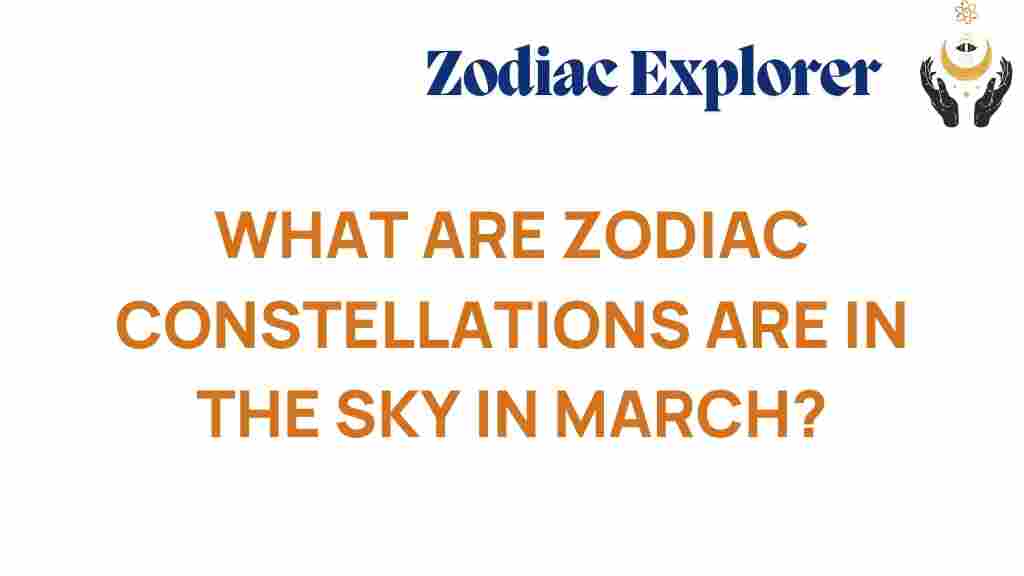Zodiac Constellations: What to Spot in March
As the nights grow longer and the chill of winter begins to wane, March offers a fantastic opportunity for stargazing enthusiasts and novices alike. The March sky presents a stunning display of zodiac constellations, each with its own unique stories and celestial events. Whether you are an avid astronomer or simply looking to enjoy the beauty of the night sky, this guide will help you uncover the wonders of the zodiac constellations visible in March.
Understanding Zodiac Constellations
Zodiac constellations are a group of twelve constellations that lie along the path of the sun, known as the ecliptic. These constellations play a significant role in astrology and have been used for centuries to predict personality traits and future events based on one’s birth month. The twelve zodiac constellations include:
- Aries
- Taurus
- Gemini
- Cancer
- Leo
- Virgo
- Libra
- Scorpio
- Sagittarius
- Capricorn
- Aquarius
- Pisces
In March, several of these zodiac constellations are particularly prominent in the night sky, making it an ideal time for skywatching.
Key Zodiac Constellations Visible in March
During March, stargazers can expect to see several zodiac constellations. Here are some highlights:
- Pisces: The constellation of Pisces is typically visible in the evening sky during March. It represents two fish swimming in opposite directions and is often associated with intuition and spirituality in astrology.
- Aries: Following Pisces, Aries makes its appearance. Known as the ram, Aries is a sign of leadership and courage and can be spotted high in the sky.
- Taurus: Taurus rises in the east after sunset, showcasing its distinctive V-shaped cluster of stars known as the Hyades, which represent the face of the bull.
When and Where to Stargaze in March
To enjoy the best stargazing experience, consider the following tips:
- Timing: The best time to observe the zodiac constellations is after sunset, particularly in the evening hours when the sky is dark. Aim for a time when the moon is less bright, as this will enhance visibility.
- Location: Find a dark area away from city lights to minimize light pollution. Parks, open fields, and rural areas are ideal.
- Weather: Clear skies are essential for stargazing. Check the weather forecast to ensure optimal conditions.
Essential Stargazing Equipment
While many zodiac constellations can be seen with the naked eye, having some tools can enhance your experience:
- Binoculars: A good pair of binoculars can help you see fainter stars and details within the constellations.
- Telescope: For a more detailed view, a telescope allows you to explore celestial bodies in greater depth.
- Star Maps: Use a star map or a mobile app to help identify constellations and navigate the night sky.
Notable Celestial Events in March
March is not only about zodiac constellations; there are also several celestial events worth noting:
- March Equinox: Around March 20, the equinox occurs, marking the start of spring in the Northern Hemisphere. This event signifies equal daylight and nighttime hours.
- Full Moon: The March full moon, often called the Worm Moon, occurs in late March and can be a beautiful sight against the backdrop of the night sky.
- Planetary Alignments: Keep an eye out for planets like Mars and Venus, which may be visible in the night sky during this month.
Step-by-Step Stargazing Guide
Here is a simple guide to help you get started with your stargazing adventure in March:
- Check the Weather: Ensure there are clear skies for optimal viewing.
- Select a Location: Choose a dark area away from city lights.
- Gather Equipment: Bring binoculars or a telescope, along with a star map or app.
- Identify the Date: Plan your stargazing for a date with minimal moonlight interference.
- Spot the Constellations: Use your map or app to locate Pisces, Aries, and Taurus.
- Enjoy the View: Take your time to observe and enjoy the beauty of the night sky.
Troubleshooting Common Stargazing Issues
Even the most seasoned stargazers can run into challenges. Here are some common issues and their solutions:
- Light Pollution: If you’re in a well-lit area, try to move to a darker location. Alternatively, use red-tinted flashlights to preserve your night vision.
- Cloudy Skies: If the clouds roll in, be patient. Check the weather forecast for breaks in the clouds or plan your stargazing for another night.
- Difficulty Identifying Constellations: Refer to your star map or app. Practice identifying bright stars that form the constellations’ outlines.
Conclusion
March is an exciting month for stargazing, especially for those interested in zodiac constellations. With the right knowledge and tools, you can unveil the beauty of the night sky and enjoy celestial events that enhance your experience. Whether you are looking to delve into the depths of astrology or simply marvel at the wonders of astronomy, the March sky has something for everyone. So grab your binoculars, head outside, and immerse yourself in the magic of the constellations!
For more information on stargazing techniques, check out this comprehensive stargazing guide. If you want to learn more about the science behind astronomy, visit NASA’s website for educational resources.
This article is in the category Signs and created by ZodiacExplorer Team
